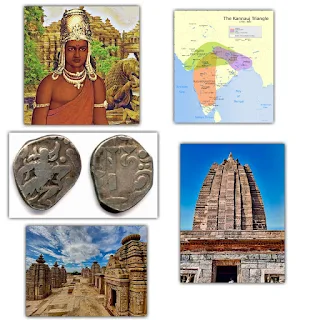ভারতের ইতিহাস উত্থান ও পতনের সাম্রাজ্যে ভরা, প্রতিটিই পাথর ও গল্পে খোদাই করা উত্তরাধিকার রেখে গেছে। আজ, আমরা প্রতিহার সাম্রাজ্যের কেন্দ্রস্থলে যাত্রা শুরু করছি, একটি শক্তিশালী রাজবংশ যা আক্রমণকারীদের বিরুদ্ধে দৃঢ়ভাবে দাঁড়িয়েছিল এবং মধ্যযুগীয় ভারতের সাংস্কৃতিক ভূদৃশ্যকে রূপ দিয়েছিল।
অভিভাবক থেকে রাজা পর্যন্তঃ
গুর্জর বংশের ছায়া থেকে উদ্ভূত হয়ে, প্রতিহাররা 8ম শতাব্দীতে প্রথম তাদের ছাপ ফেলেছিল। রাজস্থানের দুর্গম ভূখণ্ডের মধ্যে অবস্থিত তাদের রাজ্য প্রথম নাগভট্টের মতো সম্রাটদের নজরদারির অধীনে বৃদ্ধি পেয়েছিল, যিনি আরব আক্রমণকে সফলভাবে প্রতিহত করেছিলেন। এই বিজয় গাঙ্গেয় সমভূমির প্রচণ্ড রক্ষক হিসাবে তাদের সুনামকে দৃঢ় করে, তাদের "গঙ্গার অভিভাবক" উপাধি অর্জন করে।
জাঁকজমকের যুগঃ
দ্বিতীয় নাগভট্টের সিংহাসনে আরোহণের সঙ্গে সঙ্গে প্রতিহাররা স্বর্ণযুগের সূচনা করে। উত্তর ও পশ্চিম ভারতের বিস্তীর্ণ অংশ জুড়ে তাদের আধিপত্য প্রসারিত হয়েছিল। কনৌজের মতো শহরগুলি বাণিজ্য ও প্রাণবন্ত সাংস্কৃতিক জীবনে সমৃদ্ধ হয়েছিল। বহুবিদ এবং শিল্পকলার পৃষ্ঠপোষক মিহির ভোজের মতো রাজারা বুদ্ধিবৃত্তিক অনুধাবনকে আরও উৎসাহিত করেছিলেন, একটি সাহিত্যিক উত্তরাধিকার রেখে যা এখনও অনুরণিত হচ্ছে।
ক্ল্যাশ অফ দ্য টাইটানসঃ
প্রতিহাররা অবশ্য ভয়ঙ্কর চ্যালেঞ্জের মুখোমুখি হয়েছিল। দাক্ষিণাত্যের রাষ্ট্রকূট এবং পূর্বের পাল সাম্রাজ্যের সাহসের পরীক্ষা নিয়ে তিক্ত ক্ষমতার লড়াইয়ে লিপ্ত হয়েছিল। যদিও প্রথম দিকের লড়াইয়ে বিজয় দেখা গিয়েছিল, পরবর্তী সময়ে অভ্যন্তরীণ দ্বন্দ্ব এবং রাজবংশের দ্বন্দ্ব ধীরে ধীরে প্রতিহারের নিয়ন্ত্রণকে দুর্বল করে দিয়েছিল।
পতনের আওয়াজঃ
দশম শতাব্দীর দিকে, একসময়ের শক্তিশালী সাম্রাজ্য ভেঙে পড়তে শুরু করে। উত্তর-পশ্চিম থেকে গজনভীয় আক্রমণগুলি তাদের অঞ্চল এবং মর্যাদাকে ছিন্নভিন্ন করে মারাত্মক আঘাত করেছিল। দ্বাদশ শতাব্দীর মধ্যে, প্রতিহাররা ইতিহাসের পাতায় ম্লান হয়ে যায়, স্থাপত্যের বিস্ময়কর নিদর্শন, মনোমুগ্ধকর ভাস্কর্য এবং সাহিত্যিক রত্নগুলির সমৃদ্ধ চিত্রাবলী রেখে যায়।
উত্তরাধিকার
ভারতে প্রতিহারদের প্রভাব তাদের রাজত্বকে অতিক্রম করেছিল। তাদের প্রশাসনিক কাঠামো ভবিষ্যতের রাজ্যগুলির জন্য একটি আদর্শ হিসাবে কাজ করেছিল। খাজুরাহোর জৈন মন্দির এবং মোধেরার সূর্য মন্দির তাদের শৈল্পিক দক্ষতার প্রমাণ বহন করে। সবচেয়ে গুরুত্বপূর্ণ বিষয় হল, তারা স্থিতিস্থাপকতার মনোভাবকে মূর্ত করে তুলেছিল, যা আমাদের মনে করিয়ে দেয় যে প্রতিকূলতার মুখেও সাম্রাজ্যগুলি এমন একটি উত্তরাধিকার রেখে যেতে পারে যা সময় নিজেই মুছে ফেলতে পারে না।
India's history is brimming with empires that rose and fell, each leaving behind a legacy etched in stone and stories. Today, we embark on a journey into the heart of the Pratihara Empire, a mighty dynasty that stood resolute against invaders and shaped the cultural landscape of medieval India.
From Guardians to Kings:
Emerging from the shadows of the Gurjara clan, the Pratiharas first made their mark in the 8th century AD. Their kingdom, nestled amidst the rugged terrains of Rajasthan, grew under the watchful eyes of emperors like Nagabhata I, who successfully repelled Arab incursions. This victory cemented their reputation as fierce protectors of the Gangetic plains, earning them the title of "Guardians of the Ganga."
An Era of Grandeur:
With the ascension of Nagabhata II, the Pratiharas embarked on a golden age. Their dominion expanded, encompassing vast swathes of northern and western India. Cities like Kannauj flourished, pulsating with trade and vibrant cultural life. Kings like Mihira Bhoja, a polymath and patron of the arts, further fostered intellectual pursuits, leaving behind a literary legacy that continues to resonate.
Clash of the Titans:
The Pratiharas, however, faced formidable challenges. The Rashtrakutas of the Deccan and the Palas of the east engaged in bitter power struggles, testing the empire's mettle. While the early encounters saw triumphs, internal strife and dynastic squabbles gradually weakened the Pratihara grip.
Whispers of Decline:
Towards the 10th century, the once-mighty empire began to crumble. The Ghaznavid invasions from the northwest inflicted severe blows, chipping away at their territory and prestige. By the 12th century, the Pratiharas faded into the pages of history, leaving behind a rich tapestry of architectural marvels, captivating sculptures, and literary gems.
Legacy Endures:
The Pratiharas' impact on India transcended their reign. Their administrative structure served as a template for future kingdoms. Their architectural contributions stand tall, with the Jain temples of Khajuraho and the Sun Temple of Modhera bearing testament to their artistic prowess. Most importantly, they embodied the spirit of resilience, reminding us that even in the face of adversity, empires can leave behind a legacy that time itself cannot erase.
Exploring Further:
This blog is merely a glimpse into the fascinating world of the Pratihara Empire. For those who want to delve deeper, I recommend:
- Books: "Gurjara Pratiharas and their Times" by R.S. Sharma, "Kannauj: The Ancient City and its Rulers" by P.C. Jain
- Websites: Archaeological Survey of India, Indian History Sources
- Museums: National Museum, Delhi; State Museum, Lucknow; Archaeological Museum, Gwalior
So, join me in exploring the echoes of the past, and let the rise and fall of the Pratiharas continue to inspire and teach us valuable lessons about history, resilience, and the enduring power of culture.

.png)
